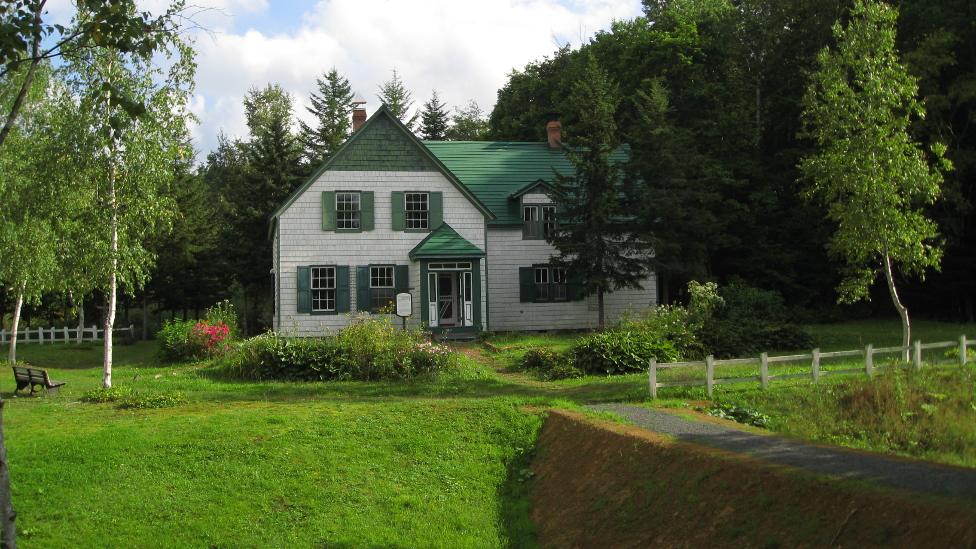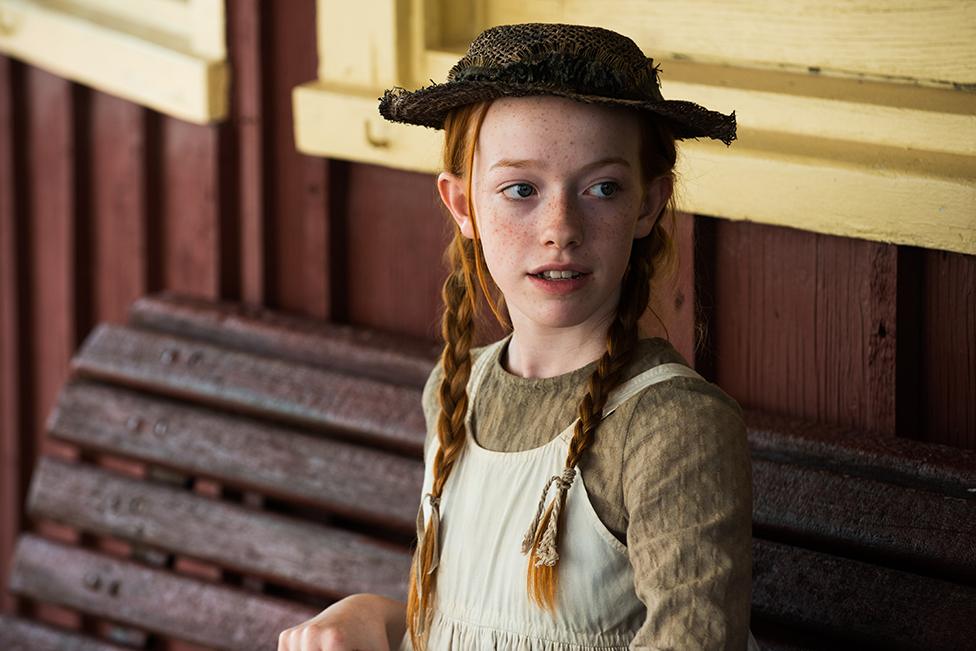Anne of Green Gables: The most popular redhead in Japan
- Published

The entrance to Canadian World in Hokkaido, Japan
With two red braids hanging from her straw hat, Anne of Green Gables may just be the most recognisable ginger-haired girl in the world. But in Japan, the orphan from Prince Edward Island is more than just a quaint Canadian import - she's a national heroine.
As he approached the farmhouse with the forest green shutters and opened the old-fashioned wooden door, Terry Dawes readied himself for what he was about to see inside. Having grown up in Prince Edward Island, Canada's smallest province, Mr Dawes had visited the famous "Green Gables" historic site many times throughout his life.
But this building that Mr Dawes was about to enter wasn't that house at all - it was an exact replica built 9,700km away, in Hokkaido, Japan. At its peak, the house - one of the main attractions at Japan's Canadian World theme park - drew 40,000 visitors a day.
Now, the park is largely abandoned, a ghost of Japan's economic heyday in the 1990s.
"I've sort of likened it to having a dream, like an uncanny dream, where you're walking down a familiar street but something's off," Mr Dawes told the BBC.

The house of Green Gables in Hokkaido, Japan is an exact replica of the real house in Prince Edward Island.
The very existence of the Green Gables replica, and of Canadian World itself, is a testament to Japan's deep love for Anne of Green Gables, says Mr Dawes, who visited Japan in 2014 to film a documentary on that subject.
This love began just before the outbreak of the Second World War, when a Canadian missionary gave her student Hanako Muraoka a copy of the book. It continues to this day with an anime series, manga comics and several Japanese movies inspired by the story.
In this way, Anne became not just a Western cultural import, but a part of Japanese culture itself, interpreted and re-interpreted by Japanese artists and writers for a primarily Japanese audience.
"Generally speaking, we are good at imitating," says Yukari Yoshihara, a literature teacher at the University of Tsukuba who includes Anne in her first-year curriculum.
"Anne of Green Gables is a part of this larger culture of adaptations."
Anne is popular with Japanese women especially, Ms Yoshihara says, because the world of Green Gables is filled with "kawaii", which means the quality of being cute, romantic and beautiful in Japanese.
"They love the story because it is full of beautiful scenery and puff sleeves and cute things, like tea parties," she says.

A Japanese tourist takes a photo outside the real Green Gables house in Canada in 2011.
But not everyone who loves Anne is a girl. Go Takahashi, a student of Ms Yoshihara's, is also a devoted fan of Anne and is writing his university thesis on the books.
"I like Anne's character. I feel attracted to a person who talks a lot, makes a little trouble, and considers others' feelings. So Anne is perfect for me," he said.
Like many other Japanese readers of the Anne stories, Mr Takahashi has made the pilgrimage to Prince Edward Island, where he visited many of the sites written about in the books - the original Green Gables house, Lovers Lane and the Haunted Wood.
About 3,500 Japanese tourists visit Prince Edward Island - population 150,000 - annually, which makes Japan one of the largest source of overseas tourism on the island.
"They come for weddings, they come to see the wildflowers, they come for theatrical or musical offerings," says the province's Premier Wade MacLauchlan.
Tourism from Japan tends to spike when a new Anne-related production is broadcast. Premier MacLauchlan expects Netflix's new series, Anne, will draw large crowds once it launches on 12 May. The co-production with the Canadian Broadcasting Corporation is helmed by Breaking Bad alumna Moira Walley-Beckett, and makes ample use of the book's feminist subtext, choosing to portray Anne more as a survivor than a saint.

Anne (Amybeth McNulty) waits at the train station in the latest retelling of Anne of Green Gables, airing on CBC and coming to Netflix 12 May.
This subtext is also essential in Japan, Ms Yoshihara says. In class, she likes to teach Anne because the book is a kind of gateway for getting students to talk about gender, which is often considered taboo in Japanese society.
"We do not usually teach kids about how gender is related to our day to day issues, like education, or fashion or how we behave," she says.
It's for this reason that Anne was probably published in Japan in the first place, she adds. Citing Japanese scholar Hiromi Ochi, Ms Yoshihara explains that Anne may have been a key part of America's plan to rapidly democratise Japan after the war.
Published in 1952 by Muraoka, who translated the story secretly during the war, the book was widely distributed in libraries run by the US State Department in Allied-occupied Japan, external. Its central story, about an orphan girl who proves her heart and mind is just as good as any boy's, served as a kind of benign liberal propaganda aimed at freeing women from traditional Japanese gender roles, she says.

Anne (Amybeth McNulty) stands on the cliffs of Prince Edward Island
It seems that core reading of Anne is still prevalent today. In his interviews with Anne fans in Japan, Mr Dawes heard over and over again how people, especially women, identified with her.
"I think Anne Shirley provides a way of acting out, to a point, without ever transgressing fully," he says. "Ultimately, she does the right thing by her family, her adopted family."
Anne is both a conformist and revolutionary, a romantic and a radical.
"In a sense we are tricked into believing that Anne of Green Gables is a dream story of liberation," Ms Yoshihara says, laughing.
But that doesn't mean Anne is loved any less.
- Published29 June 2011
- Published4 May 2017
